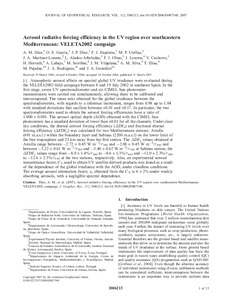Por favor, use este identificador para citar o enlazar este ítem:
http://hdl.handle.net/20.500.11765/11665
Aerosol radiative forcing efficiency in the UV region over southeastern Mediterranean: VELETA2002 campaign
| Título : | Aerosol radiative forcing efficiency in the UV region over southeastern Mediterranean: VELETA2002 campaign |
| Autor : | Díaz Rodríguez, Ana María


|
| Palabras clave : | Atmospheric aerosol; UV irradiance; Spectroradiometer; Spectroradiometers |
| Fecha de publicación : | 2007 |
| Editor: | American Geophysical Union |
| Citación : | Journal of Geophysical Research: Atmospheres. 2007, 112(D6), p. 1-13 |
| Versión del editor: | https://dx.doi.org/10.1029/2006JD007348 |
| Resumen : | Atmospheric aerosol effects on spectral global UV irradiance were evaluated during the VELETA2002 field campaign between 8 and 19 July 2002 in southeast Spain. In the first stage, seven UV spectroradiometer and six CIMEL Sun photometer measurements were carried out simultaneously, allowing them to be calibrated and intercompared. The mean ratio obtained for the global irradiance between the spectroradiometers, with regards to a reference instrument, ranges from 0.98 up to 1.04 with standard deviations that oscillate between ±0.01 and ±0.17. In particular, the two spectroradiometers used to obtain the aerosol forcing efficiencies have a ratio of 1.000 ± 0.001. The aerosol optical depth (AOD) obtained with the CIMEL Sun photometers has a standard deviation of lower than ±0.01 for all the channels. Under clear sky conditions, the diurnal aerosol forcing efficiency (DDFe) and fractional diurnal forcing efficiency (DFDFe) was calculated for two Mediterranean stations: Armilla (691 m.a.s.l.) within the boundary layer and Sabinas (2200 m.a.s.l) on the lower limit of the free troposphere and 25 km away from the first station. The DDFe values obtained at Armilla range between _2.72 ± 0.45 W m_2/t380 and _2.88 ± 0.45 W m_2/t440 and between _3.22 ± 0.61 W m_2/t380 and _3.40 ± 0.62 W m_2/t440 at Sabinas station; the DFDFe values range from _8.0 ± 1.4%/t380 to _8.6 ± 1.3%/t440 and _12.0 ± 2.3%/t380 to _12.6 ± 2.3%/t440 at the two stations, respectively. Also, an experimental aerosol transmittance factor, CT, used to obtain UV satellite derived products was found as a result of the dependence of the global irradiance with the AOD, under cloudless conditions. The average aerosol attenuation factor, h, obtained from the CT, is 6 ± 2% under weakly absorbing aerosols, with a negligible spectral dependence. |
| Patrocinador: | This work was supported by CICYT–MCYT through the coordinated projects CGL2004-05984-C07-05 and CGL2005-03428-C04-02. |
| URI : | http://hdl.handle.net/20.500.11765/11665 |
| ISSN : | 2169-897X 2169-8996 |
| Colecciones: | Artículos científicos 2005-2009 |
Ficheros en este ítem:
| Fichero | Descripción | Tamaño | Formato | ||
|---|---|---|---|---|---|
| Aerosolradiative.pdf | 1,27 MB | Adobe PDF |  Visualizar/Abrir |
Los ítems de Arcimis están protegidos por una Licencia Creative Commons, salvo que se indique lo contrario.





